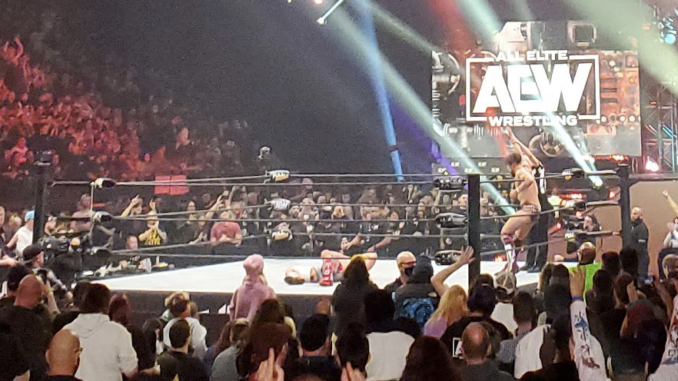
SPOTLIGHTED PODCAST ALERT (YOUR ARTICLE BEGINS A FEW INCHES DOWN)...
AEW is a Cinderella story that has only been half-told. I don’t mean to imply that FTR wishes on pumpkins, Tony Khan talks to mice, or Toni Storm ditches a shoe every time she leaves the room, but AEW’s creation fits with the spirit of the fairytale. Whenever I hear Oscar Hammerstein’s iconic lyrics, “Daft and dew-eyed dopes keep building up impossible hopes,” I think about AEW and how impossible its existence once seemed. Five years ago, few people could have predicted AEW’s success, and when criticizing the company, it is easy to forget that it is a miracle it exists at all.
That miracle also makes it easy for fans to overlook fixable flaws in the company, and AEW should avoid falling into that trap themselves. Just because something is miraculous doesn’t mean it is as good as it can get. If AEW wants to keep the “miracle” going and make it to the other half of its story, the people running it cannot become complacent. Satisfaction is a good, satiating feeling, but it should never become all-encompassing. When satisfaction takes over, people lack the motive to question things, the drive to see things through, and the passion to be more than the things they already are.
That is not to say that the people working for AEW lack passion. It is obvious they are filled to the brim with passion; you can see it in every show they put on. However, the shows they have been putting on these past couple of months have been riddled with fixable mistakes. I’m not talking about narrative mistakes, wrestling mistakes, or creative mistakes. Every company has those kinds of mistakes, and they’re already talked about enough. I’m talking about technical mistakes.
Talking about technical mistakes may seem pedantic at first glance, but technical mistakes can be extremely detrimental to even the finest product. Just imagine if Cinderella’s dress had blinked in and out of existence like a broken light bulb halfway through her first dance with Prince Charming. Her spectacular story might have ended in a puddle of impossible hopes that almost came true but didn’t.
So, with that said, as much as I cannot believe a company as spectacular as AEW has managed to exist in a world where that was thought to be impossible, I also cannot believe that a company as well-funded as AEW, a company with a product as good as AEW’s, and a company with employees as passionate as AEW’s keeps putting out shows with production errors. Most of these errors are small; however, this weekend, we witnessed two particularly startling errors.
On Saturday’s episode of AEW Collision, right before the airing of a Keith Lee promo – a promo I found very entertaining – AEW accidentally broadcast a person who I assume is their 2nd AC. The majority of this person’s body appeared on screen; they then called out a number and clapped their hands in front of the camera in what appeared to be a substitute for using a clapperboard. Of course, I have no way of knowing if this person actually was AEW’s 2nd AC or not, but the reason I assume this to be a possibility is because the 2nd AC is usually the person in charge of the clapper on most professional productions.
Originally, I had assumed this mistake was a one-off, shrugged my shoulders, and used a voice recorder to dictate a quick quip for my Hits & Misses column. Like most of the “jokes” I come up with for that column, the joke I had planned wasn’t really all that good in the first place. It was a half-hearted riff with a barely-there punchline about needing to buy a billionaire a clapperboard. Luckily for me and my thousandaire budget, I did not have to worry about Tony Khan’s lack of clapperboards because, somehow, against all evens and odds, we saw the production crew “manage to screw up a second time,” and the viewers at home got a chance to revisit the 2nd AC while they utilized an acrylic clapperboard right before a Ricky Starks promo — a promo I also happened to enjoy. (Maybe their 2nd AC is a lucky charm and should guest star more often?)
Now, for anyone who is reading this but doesn’t watch AEW, I want to be clear that I am not implying they normally have errors of this magnitude. This is not the norm for them, and it was definitely one of their more flagrant mishaps. Still, despite how obvious these two errors were (and perhaps the second error was intentional, trying to make the first error look like it was part of a bit or a story they’re telling), they wouldn’t have been worth writing a column about all on their own, but they were not on their own. That same show also had an audio error during a Swerve Strickland promo, and AEW seems to have other small but notable errors on a near-weekly basis.
Don’t get me wrong, and don’t get it twisted; I know from firsthand experience that live television is hard. It is very hard, and even the slickest of productions catch mistakes, but mistakes are supposed to be rare. While AEW’s technical mistakes may not always be of this scope and scale, they are not rare.
That doesn’t mean I don’t respect the people who work behind the scenes in professional wrestling. On the contrary, I respect them very much, but I feel like many of them were trained in film schools, and many film schools don’t train you to do the things they are being asked to do. I know this because I studied film at the University of North Carolina School of the Arts. UNCSA is an amazing school, and I recommend it to anyone who is sincerely interested in filmmaking. I learned so much at that school, and I am so grateful to the instructors who went above and beyond to share their knowledge with me. However, a lot of that knowledge they shared is not something that could be easily applied to what goes on during a live professional wrestling broadcast.
Despite having studied film, I am not sure I could do much better without a lot of practice and training. I could make the lighting look good, make sure none of the images are soft, help adapt promos into scripts, and edit emotionally stirring hype videos. However, I would struggle to perfectly capture every important aspect of a live wrestling match, and I’ve watched professional wrestling since I was a child. I cannot imagine how hard it must be for the members of the production team who have not grown up watching wrestling.
These are people who very likely know how to make movies, tape sitcoms, and capture live sporting events and news broadcasts, but professional wrestling is an entirely different animal. There is nothing else on television quite like the theatrical production that is professional wrestling, but there has been in the past.
In 1957, CBS spent $376,000 (the equivalent of $4 million today) to produce the most-watched broadcast in television history. 107 million people in a country with a population of 167 million people tuned in to watch a live broadcast of the first musical ever written for television: Rodger & Hammerstein’s “Cinderella.”
So many people watched this production that, according to contemporaneous reports, the bustling streets of Manhattan were described by Jon Cypher as being deserted during the broadcast. This broadcast was a monumental achievement that dazzled the world with overlay effects, classic songs, and the first-ever nationally distributed performance of a 21-year-old Julie Andrews.
This 20th-century miracle is considered one of the shiniest jewels in the crown of the Golden Era of Television, and it featured over half a dozen set pieces, more than 100 costumes, 33 musicians, 56 actors, and 80 crew members. It lasted for 76 minutes, and not one single copy of that historical broadcast exists today.
There was a kinescope made, but we no longer have it. It has been lost to time. However, what we do have is a different kinescope of a live dress rehearsal that was never shown to the cast and was believed to have been destroyed. In 2002, its existence was discovered by accident when it was found inside a canister that had been mislabeled as holding a 16-millimeter, five-minute segment of a Julie Andrews performance.
This kinescope was created during a dress rehearsal that took place two weeks before the broadcast, and it had been filmed exactly as if it were the live production itself. The original kinescope was kept at the Museum of Television and Radio in New York City until it could be transferred into a digital format. Now, in 2023, a copy of that delicate kinescope is available to view both online and on DVD. Needless to say, as someone who studied filmmaking, I have seen it, and I can tell you that in an era where cameras were the size of vending machines and microphones were made out of fragile ribbons and vacuum tubes, a live dress rehearsal had fewer notable production-related errors than this week’s episode of AEW Collision.
Unlike the 1957 production of Rodger & Hammerstein’s Cinderella, AEW Collision has the benefit of 66 years of live broadcasting experience that the producers of that 1957 broadcast did not have. To quote Rick On Theater’s blog, “The 1957 Cinderella company weren’t breaking rules or pushing the envelope; they were trying to invent the rules because there weren’t any yet.”
The reason I have taken the time to type out all of these details is because I wanted to make the point that seemingly impossible things are not always impossible; sometimes, they’re just really, really hard. But “really hard” still means doable, and if a 1957 production crew – one that was blindly feeling its way through uncharted waters – could pull off a miracle that is still being taught in film schools to this day, AEW’s production crew can pull off the miracle of finding a way to broadcast their product without detrimental errors.
If these kinds of adverse errors had only happened on this week’s episode of Collision and nowhere else, I wouldn’t be writing all of this, but that isn’t the case, and so I am. AEW’s production errors are bordering on the perilous edge of systemic. They’ve missed finishes, they’ve cut to crowd shots that do not make sense in the flow of what is happening, and they’ve even missed airing an attack from behind that was pivotal to a recent storyline. They have cut to an empty stage in the middle of matches, missed multiple eliminations in the same battle royal, and at one point in time, there was even audio that bled through from another channel. (To be honest, I highly doubt that last mistake was AEW’s fault, but regardless of whose fault it was, it needs to be fixed.)
AEW’s in-ring action is the proverbial belle of the ball, and everyone involved with AEW should be proud that they have one of the best products available in the U.S. market. However, the presentation of that product matters almost as much as what the product itself contains. Vince Russo was wrong about a lot of things, but the name of his “Pyro and Ballyhoo” podcast makes an apt point. While “pyro and ballyhoo” isn’t the be-all and end-all of professional wrestling, it is still a major part of it, and in the long run, it could make the difference between “a lovely night” and the clock striking “12” two seconds too soon. The reason for this is because, to a lot of casual fans, a wrestling product without its slick presentation and well-told stories is just a very elaborate and very dangerous fixed fight.
AEW will get better at this. I have no doubt that they are already trying to improve their product’s production, but maybe they need to try something different? I would never call for someone’s job, and I don’t want anyone to lose their job over what happened this week.
I’ll end this paragraph with a short anecdote. Stanely Kubrick fired a 2nd AC on his first day at work because he happened to carry a magazine upside down. Now, that is an extreme thing to do, and to be honest, it makes me think less of Kubrick, but nobody can deny the quality of Kubrick’s work, and nobody can deny he didn’t just try to do things; he did them. He did things that took dozens of takes, things that infuriated his co-workers, and things that studios told him would be impossible to do.
That’s the thing with film, television, and live broadcasts. Everything in this business feels like it is impossible until you do it. Every show, every movie, and every live event that takes place is a small miracle, and it takes a small army of miracle workers to make those miracles happen. I don’t think AEW needs to replace their miracle workers. Few people in the world work as hard as film crews. People have died from being overworked on film sets. The 2nd AC on Pleasantville, Brent Lon Hershman, died in a car accident after a 19-hour shoot.
So please, don’t get me wrong; I respect the people who work behind the scenes on these shows, but many of them were trained in film schools. They know how to make almost anything, but professional wrestling is different than almost everything. Wrestling is more like the live broadcast of the 1957 production of Rodger & Hammerstein’s “Cinderella” than a football game.
Wrestling is a live play that is filmed in real-time. It is one of those things that takes a miracle to film correctly, and the secret to making that miracle happen is the same today as it was in 1957: a lot of practice, a lot of training, and if all else fails, try a dress rehearsal and capture it via kinescope because that would be hilarious.
However, all jokes aside, I’m not writing this column to drag AEW. I’m writing this column because I believe in AEW. I believe they are going to be around for a long time to come, and I believe they will finish their Cinderella story in spectacular fashion as long as they do not become complacent or satisfied with the impossible things they have already achieved. After all, the only thing better than achieving a lot is achieving more, and as Oscar Hammerstein said in the second half of the iconic lyrics I mentioned at the start of this column, “Impossible things are happening every day.”
David Bryant studied screenwriting at the University of North Carolina School of the Arts and Broadcast and Cinema at UNC-Greensboro. David is an entertainer, promoter, and published author, as well as a former Mr. NC USofA, Mr. SC United States, Mr. KY EOY, and Mr. National Don’t H8. His Twitter, Instagram, and Threads accounts can be found at @IamDavidBryant




Leave a Reply
You must be logged in to post a comment.